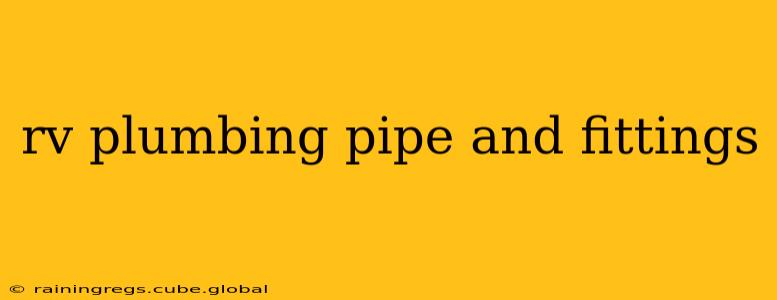Maintaining your RV's plumbing system is crucial for a comfortable and enjoyable travel experience. Understanding RV plumbing pipe and fittings is the first step towards ensuring reliable water supply and waste disposal. This comprehensive guide will delve into the specifics of RV plumbing, addressing common questions and concerns.
What Type of Pipe is Used in RVs?
RVs predominantly utilize PEX (cross-linked polyethylene) tubing for their plumbing systems. PEX is chosen for several key reasons: its flexibility allows for easier installation in tight spaces, it's resistant to freezing (though precautions should still be taken in extremely cold conditions), and it's relatively lightweight. While other materials like CPVC (chlorinated polyvinyl chloride) are sometimes found in older RVs, PEX has become the industry standard due to its superior properties.
What Size Pipes Are Commonly Used in RV Plumbing?
The pipe sizes used in RV plumbing vary depending on the application. However, you'll commonly find ½-inch and ¾-inch diameter PEX tubing. ½-inch is typically used for cold water lines, while ¾-inch is more common for hot water lines to accommodate higher flow rates. Always check your RV's specific plumbing diagram for the exact pipe sizes used in your model.
What Are the Different Types of Fittings Used in RV Plumbing?
RV plumbing fittings are designed for ease of installation and durability. Common types include:
-
Compression Fittings: These fittings use compression rings to secure the PEX tubing, making them easy to install and remove without the need for soldering or specialized tools. They are a popular choice for RV plumbing due to their simplicity and reliability.
-
Push-to-Connect Fittings: These fittings require no tools for installation; you simply push the PEX tubing into the fitting until it clicks. While convenient, ensure you use the correct fitting for your pipe size to prevent leaks.
-
Barb Fittings: These fittings use a barbed end to grip the tubing, typically secured with a clamp. They are less common in modern RV plumbing but might be encountered in older systems.
How Do I Repair a Leaky RV Plumbing Fitting?
A leaky fitting can quickly turn a pleasant trip into a frustrating one. If you discover a leak, the first step is to identify the source. Often, it's simply a loose fitting. Try tightening the fitting (carefully!) with an appropriate wrench. If this doesn't solve the issue, you may need to replace the fitting entirely. Remember to turn off the water supply before attempting any repairs. If you're not comfortable performing the repair yourself, consult a qualified RV technician.
Can I Use Standard Plumbing Fittings in My RV?
While some fittings might appear similar, it's generally not recommended to use standard plumbing fittings in your RV. RV plumbing systems often operate under different pressures and conditions, and standard fittings might not be designed to withstand these. Using the correct RV-specific fittings ensures the system's integrity and prevents leaks.
What Materials Should I Avoid When Working With RV Plumbing?
Avoid using materials that are not compatible with PEX tubing or are not designed for potable water applications. Using inappropriate materials can lead to leaks, damage to your system, or even contamination of your drinking water. Always use fittings and components specifically rated for RV plumbing systems.
This guide provides a solid foundation for understanding RV plumbing pipe and fittings. Regular inspection and proper maintenance will help ensure your RV's plumbing system remains in optimal working condition, providing you with peace of mind on the road. Remember, if you are unsure about any repair or maintenance task, it's always best to seek professional assistance from a qualified RV technician.
